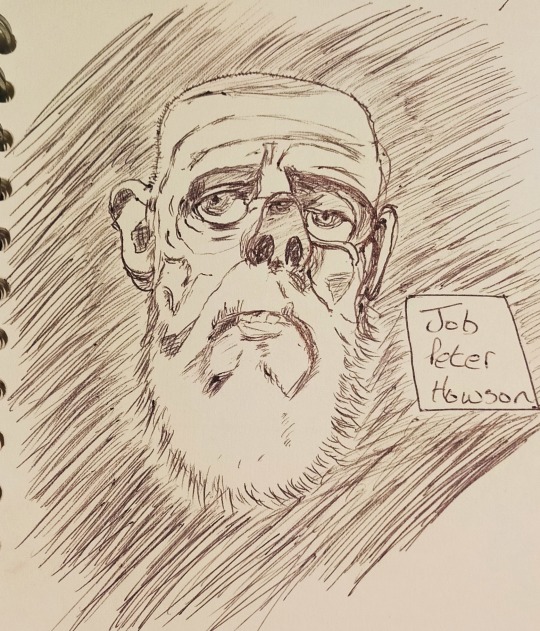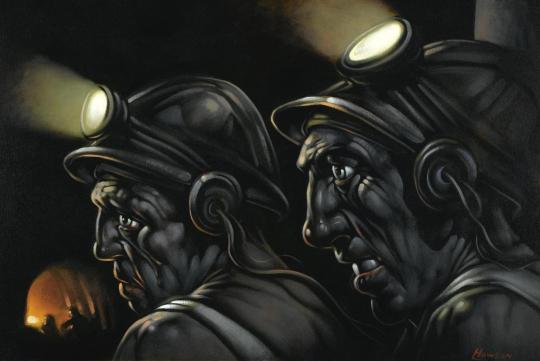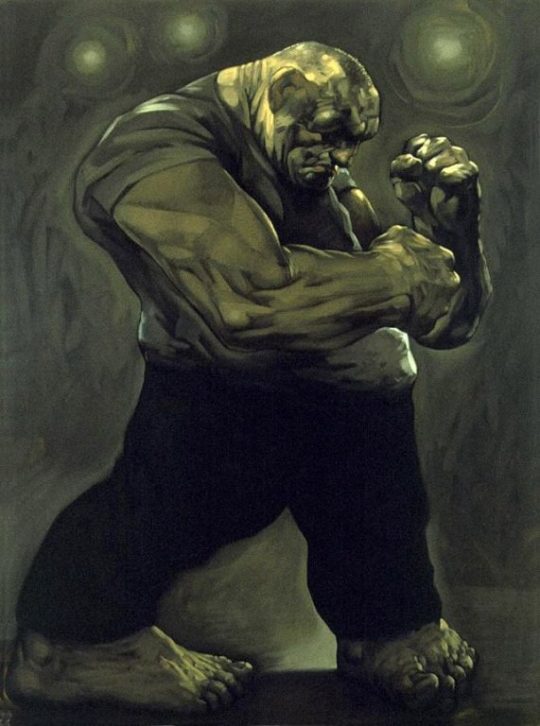#Peter Howson
Text

Peter Howson — D'Artagnan (oil on canvas, 1998)
50 notes
·
View notes
Text
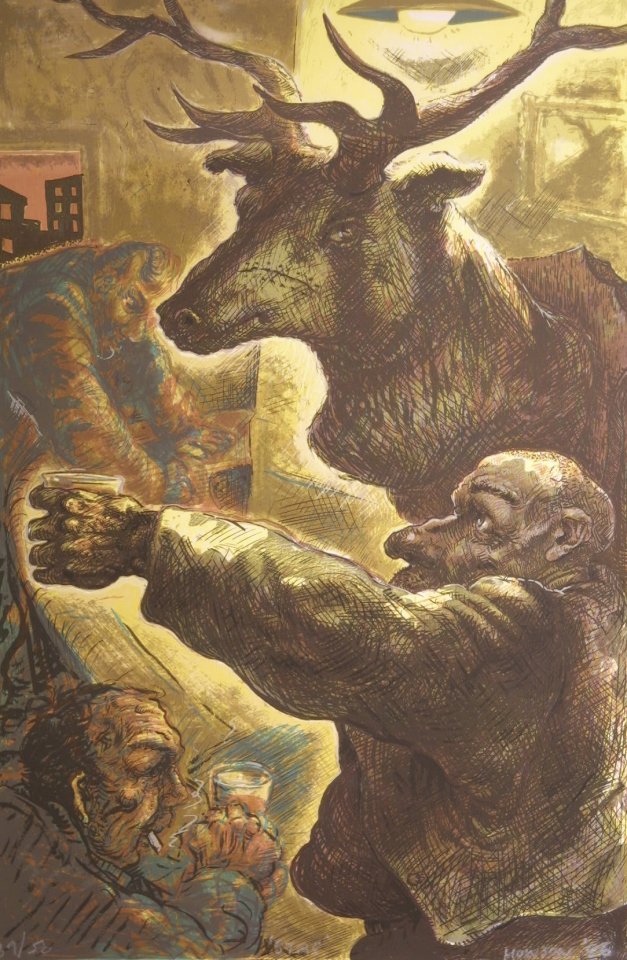
Peter Howson, Stag (1986)
5 notes
·
View notes
Photo
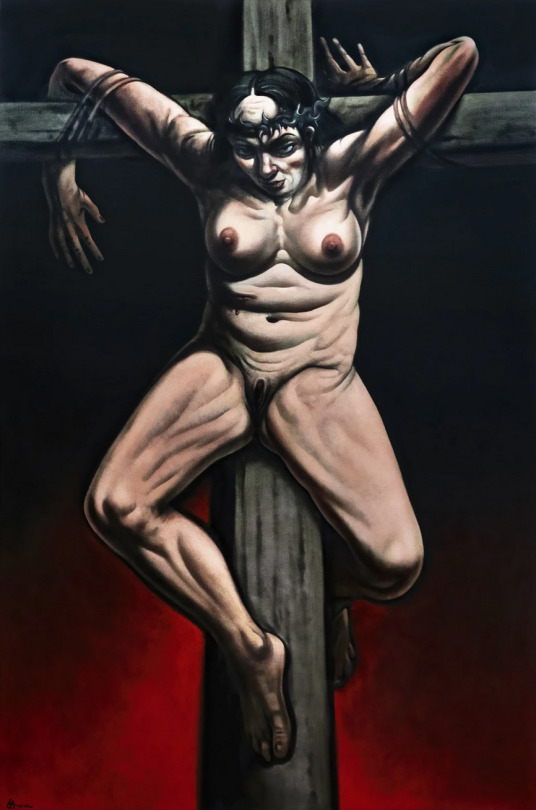
The Crucifixion by Peter Howson
17 notes
·
View notes
Text

Peter Howson: A Brush with Evil: Holocaust Crowd Scene II. This monumental canvas, a visceral and haunting representation of the horror and brutality of the Nazi concentration camps, depicts Jewish prisoners in various attitudes of grief, suffering and lamentation.
This painting graphically depicts the horror and brutality of the Nazi concentration camps with the crowd of Jewish prisoners, stripped of their own clothing and dressed in striped camp uniforms, depicted in attitudes of grief, suffering and lamentation. They are flanked by two thuggish Nazi guards wearing swastika armbands, one making a Nazi salute and the other pointing inward to focus attention on a prisoner prominently displaying the yellow badge with the Star of David that Jews were forced to wear in Nazi-occupied Europe, used here symbolically to indicate martyrdom.
Peter Howson, Holocaust Crowd Scene II, 2011 | Ben Uri Gallery and Museum
Holocaust Crowd Scene II | Art UK
0 notes
Text
Amanda -- Peter Howson
Amanda — Peter Howson
Amanda, 1987 by Peter Howson (b. 1958)
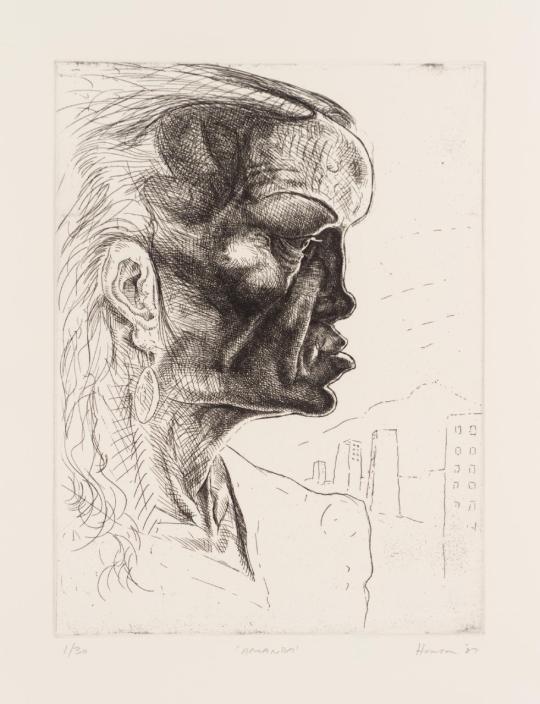
View On WordPress
0 notes
Text
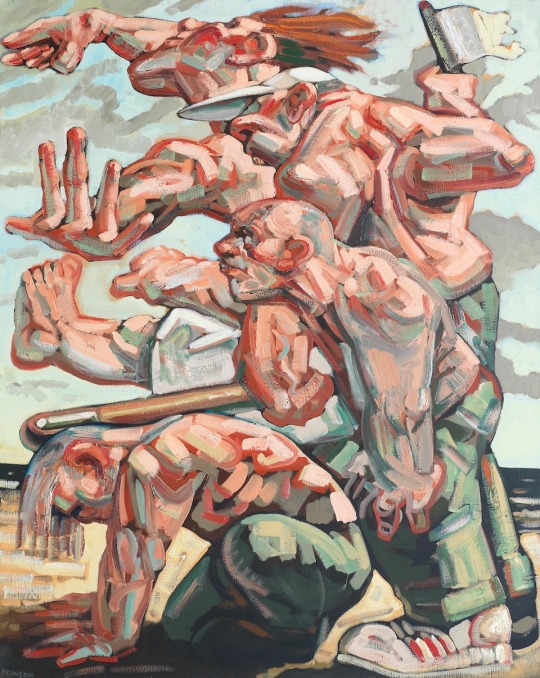
Peter Howson OBE (British, born 1958)
Totem
signed 'HOWSON' (lower left), titled and signed 'HOWSON' (on stretcher)
oil on canvas
Bonhams
57 notes
·
View notes
Text
Just out in Foreign Policy is my review of three of the crop of 2023 — Michael Lewis’ Going Infinite, Zeke Faux’s Number Go Up and Peter Howson’s Let Them Eat Crypto.
archive: https://archive.ph/SicAy
This was written over November and delivered to Foreign Policy in early December. But the paper’s been a little busy with the war in Gaza and so forth. Thankfully it’s still applicable.
(My $5-and-up patrons got to read the draft version two months ago. The bit about how John Jay Ray turned out right about everything got cut for space, sadly.)
I was also going to do Ben Mackenzie and Jacob Silverman’s Easy Money — but that already got a great Foreign Policy review in November! From the American Enterprise Institute, no less. And I was already coming up to 3,000 words. https://archive.is/rKUmg
4 notes
·
View notes
Photo

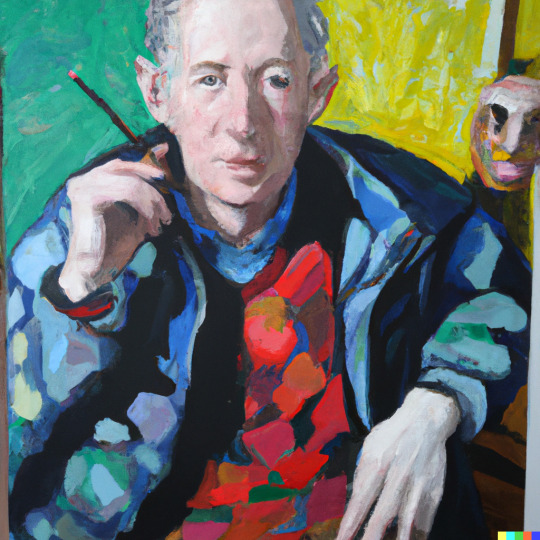


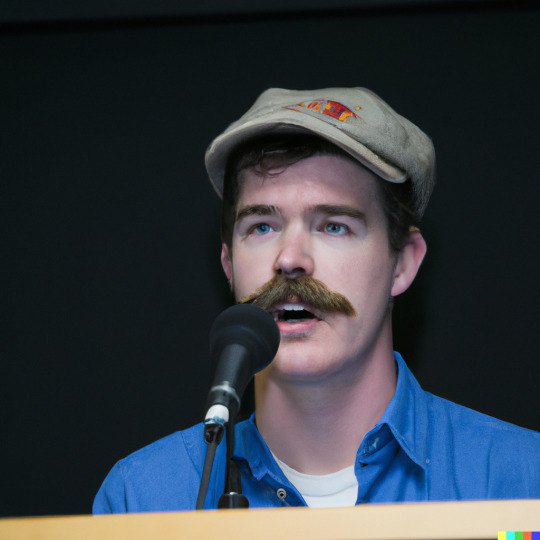

Martin Gore, painter Peter Howson, musician Yeule, poet Tomas Tranströmer, filmmaker Lorcan Finnegan and musician Matt Quinn of Mt. Joy as Representatives for the New Act of the Consecration of Man
#Martin Gore#Depeche Mode#Yeule#Tomas Tranströmer#Lorcan Finnegan#Matt Quinn#Mt. Joy#Peter Howson#ai#gen art
0 notes
Text
Bleak cover, but unsurprising given the nature of the album.

Live - Throwing Copper (Radioactive/MCA, 1994) - Illustration by Peter Howson
The painting is called "Sisters of Mercy" and was painted by Howson in 1989. He explains the meaning of the painting in a 2005 Herald Scotland article:
This painting was done at a time when I was walking on the road to self-destruction [...] The man in the painting is blind, and he is troubled because there is no-one to guide him. He is clutching a red Bible, trying to find sanctuary in the cliff-edge church, but that is now derelict. Finally, he will be led over the edge and fall to his doom. The girls do not care and it is all a bit of fun for them. Obviously this is not my most optimistic creation, but I am glad when something moves people to question our existence.
Yeesh, take that as you may.
Fun fact: the original painting was sold at Christie's New York at a 2005 auction. The price? $186,000. Lucky Pete.
Image courtesy of Stereogum.
4 notes
·
View notes
Text
Compass Gallery
Compass Gallery, Glasgow's oldest contemporary art gallery established in 1968, has been a pivotal force in supporting emerging artists, both new graduates and established talents.
The gallery showcases a monthly program featuring solo and themed exhibitions, including the renowned 'New Generation Show.' Since its founding in 1969, the gallery has actively scouted fresh talent across Scotland, fostering a lively arts scene. Pioneering initiatives like Christmas Shows and New Generation Shows have become industry standards.
Compass Gallery, originally founded as the New Charing Cross Gallery, evolved under the guidance of Cyril Gerber into a prominent player in the Glasgow art scene. Notable artists, including Peter Howson and Jennifer McRae, debuted as new graduates in annual exhibitions, a groundbreaking concept initiated by Gerber.
The gallery's contributions extend to exhibiting mature artists like David Bellany and Elisabeth Frink, highlighting its enduring influence on Scottish contemporary art. With a friendly atmosphere and an engaged staff, Compass Gallery continues to enrich Glasgow's artistic landscape with its imaginative and diverse exhibition program.
Strange Field
Strange Field, established in 2012, is a dynamic platform fostering creative experimentation, learning, and development, with a strong commitment to underrepresented and early-stage career artists. Situated at both French Street and The Pipe Factory in Glasgow's East End, Strange Field envisions accessible creative platforms embedded in communities, catalysing increased creative development, education, experimentation, and inclusion.
The organisation prioritises supporting underrepresented and early-career artists, emphasising accessibility and resilience within the arts. It actively engages with the local community in Glasgow's East End as a catalyst for creative change and improved quality of life through cultural activities.
Striving for best practices, Strange Field operates with a non-hierarchical governance model known as Policy Governance or Carver Governance, fostering co-operative working and organisational resilience.
The curated programme includes exhibitions, events, residencies, and workshops, focusing on early career and underrepresented artists. Strange Field provides affordable studios for artist production, a unique application writing support service, and is actively working towards an open community art school at The Pipe Factory.
French Street offers affordable, first-come-first-served studios with rates inclusive of bills, ranging from £95 to £200 per month. While the studios are wheelchair accessible, there is currently no accessible WC. Studios provide 24-hour access, Wi-Fi, and open-plan spaces with natural daylight.
Strange Field is expanding its studio provision at 111/113 French Street and developing an alternative arts education program—a community art school—to overcome barriers preventing diverse participation in creative activities.
In summary, Strange Field stands as a vibrant hub supporting artists and communities, embodying inclusivity, creative exploration, and a commitment to fostering emerging talent.
The Pipe Factory
Friends of The Pipe Factory, driven by a Regeneration Capital Grant Fund award of £1,965,354, is set to transform Glasgow's B-listed Pipe Factory into a vibrant community and creative hub. Originally a clay smoking pipe factory from 1877 to 1955, the building's renovation project aims to revitalise it as a facility for creative activity and community well-being. The grant will facilitate internal remodelling, installation of new facilities, energy-efficient systems, and various upgrades, honouring the building's historical significance.
The Pipe Factory, built in 1876-79, designed by architect Matthew Forsyth, once employed over 500 people producing up to 14,000 clay pipes a day. Closed in 1955, the building's current project seeks to refire it as a creative and community space.
Between 2012 and 2018, The Pipe Factory Ltd ran a successful program with residencies, exhibitions, and events. In 2016, emergency repairs were undertaken, including replacing windows and a new slate roof, supported by Glasgow City Council and the Architectural Heritage Fund.
The Pipe Factory Ltd, now trading as Strange Field, played a pivotal role in creating a cultural resource in Glasgow's East End. Friends of The Pipe Factory CIC, formed in 2020, aims to continue this legacy by purchasing and redeveloping the iconic building into a creative social enterprise.
The grant will fund internal remodelling, installation of a new lift and secondary staircase, building fabric repairs, energy-efficient systems, and replacements of windows and doors, making the building accessible and sustainable.
Friends of The Pipe Factory CIC outlines six main outcomes, including increased community engagement, improvements in physical and mental well-being through arts programs, new learning opportunities, pathways to employability, support for creative industries, and the preservation of heritage.
In March 2021, Friends of The Pipe Factory purchased the building as a community asset, fuelling their ambition to create a permanent home fostering creativity and individual learning, with young people and communities at its heart.
Barras 100, a year-long celebration of the 100th anniversary of The Barras market, is the first creative project by Friends of The Pipe Factory, showcasing the building's commitment to community engagement and cultural celebration.
This ambitious project, driven by a passionate group of organisations, aims to breathe new life into The Pipe Factory, offering a space for collaboration, learning, and creative experimentation that will benefit both individuals and the wider community.
Transmission
Transmission, established in 1983, stands as a pivotal artist-run organisation in Glasgow, embodying a commitment to autonomy while being intricately connected to its membership and communities. Operating as the longest-standing artist-run space in Glasgow, Transmission engages in diverse activities, including exhibitions, events, exchanges, residencies, and publications. It serves as a social hub, fostering a present-day community while housing an archive of materials tied to its gallery's history and membership.
Transmission collaborates with artists across various initiatives, providing a platform for the production of exhibitions, events, and publications. It also facilitates exchanges, residencies, and shares resources with its membership to support activities beyond its programming.
While labouring under the banner of autonomy, Transmission acknowledges its deep interdependence on factors and players influencing its operational parameters. As a registered charity, it sustains itself through a combination of state funding, voluntary labor, and the ongoing construction of its community.
Engrained in its constitution is the commitment to keeping all Transmission activities and resources free, ensuring fair pay for everyone involved, including artists and creative practitioners. This commitment coexists with the voluntary nature of the committee managing and programming Transmission.
Beyond being an exhibition space, Transmission serves as a vibrant social hub, fostering a dynamic community of artists, creatives, and supporters. Its activities aim to bridge the gap between autonomy and the collaborative efforts that sustain its existence.
As a registered charity, Transmission embodies its commitment to fair pay and free access through a unique organisational structure managed by a voluntary committee. The committee, consisting of six individuals, operates under the ethos of Transmission, with successive two-year terms.
Transmission, with its rich history and ongoing commitment to artistic freedom, fair pay, and community engagement, remains a cornerstone in Glasgow's artist-run landscape, showcasing the intricate balance between autonomy and collaborative efforts in sustaining a vibrant creative space.
Glasgow Project Room
Established in 1997, the Glasgow Project Room originated as a space for studio members to showcase their work. Located on the first floor of the Trongate 103 centre, it has evolved into a dynamic project space that supports both the studios and a broader audience, hosting exhibitions and events by artists locally and globally. The Project Room operates without direct funding, requiring artists to fund and manage their own shows.
The studio offers an open-plan system fostering support and dialogue among a diverse community of artists working in various media. Artists in the studios have gone on to further education and international exchanges. To apply for studio space, artists can contact the committee by email or telephone, and successful applicants must demonstrate a commitment to being a visual artist and the artistic use of the studio.
Artists and curators are invited to submit proposals to Glasgow Project Room by sending six examples of their work, a CV, and an outline of their intentions for the space to [email protected]. The committee reviews proposals every three months, and responses may take this duration.
0 notes


